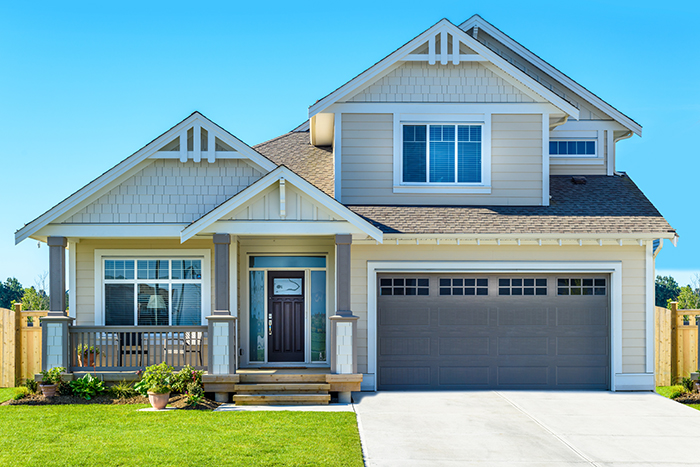French drain: how to better protect your investment
Are you a homeowner, or thinking about buying your dream home? Welcome to a world where technical terms add up almost as quickly as the decisions to be made. One of these is the French drain, also known as a foundation drain, which crops up in inspection reports, property descriptions and even in conversations with neighbours. Most of the time, we forget about it. Until the day when water gets into the basement, bringing with it dampness, mould... and a whole lot of stress.

You usually can’t see it – it was buried underground decades ago – but the foundation drain is one of those critical components that you need to keep an eye on to avoid any issues. This guide covers everything you need to know about French drains, from what they do to the regulations governing them in Quebec, as well as the signs to look out for and what you should do to maintain them. After all, what goes on under your feet can have real consequences for the solidity, comfort and value of your property.
What is a French drain and what is it used for?
A French drain is much more than just a technical feature. This inconspicuous system installed underground around the house plays a key role in keeping water away from the foundation before it seeps in where it shouldn’t. When properly installed, it helps prevent water infiltration in the basement, cracks in the concrete and all the problems associated with dampness.
In practical terms, a French drain system is composed of a perforated pipe, called a weeping tile, laid in a gravel-filled trench and wrapped in a geotextile membrane.Water that pools in the ground is collected and then redirected to a drainage point – often a storm sewer or sump – by sloping the land or designing landscaping to promote the natural flow of water. There are two main types of French drains. The exterior version is installed around the foundation, usually when the house is built. The interior French drain is often added during renovations and usually works with a sump pump, which expels the water to the outside. This type of French drain should not be confused with a floor drain, which is used to evacuate water directly inside the house, as in a laundry room or garage. Similarly, it's important not to confuse a French drain with a trench drain (also sometimes called a channel drain). A trench drain is a linear drain with a visible grate at the surface, typically installed in paved areas like driveways, patios, or walkways to capture and quickly remove surface water runoff.
In both cases, effective land drainage and a proper slope are essential for a French drain to work properly, especially if your home is particularly prone to humidity.
Quebec requirements for French drains
In Quebec, foundation drains have been the standard in new construction since 1955, when the Building Code began requiring them for any home with a basement. So if you live in a newer home, chances are it has a French drain.
Even if a drainage system is in place though, there’s no guarantee that it’ll always work properly. After several decades underground, a French drain may stop doing its job, and you may not notice it – at least, not right away.
If you want to know whether your house has one, you can look at the building plans, if the previous owner gave them to you. Otherwise, you can contact your local municipality or borough of Montréal to request a building plan for your property.
When a French drain becomes a liability rather than a solution
Even if your French drain was properly installed, it won’t protect you forever. What’s more, over time, if it wasn’t installed correctly, it can stop working, sometimes without warning. The impact is often felt first in the basement, where it’s easiest for moisture to seep in. And if your home isn’t equipped with such a system, the risks are the same: not having a French drain can cause as much damage as a faulty one.
Signs to look out for that point to a faulty French drain
There are a number of clues that can tip you off.
- Water pooling near the foundation: Often the first sign of an ineffective foundation drain, this pooling can lead to cracks in the concrete and water leaks in the basement.
- Persistent dampness in the basement, even when there’s no rain: This may indicate a drainage problem.
- Mould stains: These are usually visible on walls or floors.
- Efflorescence: These are whitish deposits on the foundation walls caused by moisture.
- Persistent damp smell: A basement that always smells musty may indicate hidden infiltration.
- Abnormal indoor humidity levels: The recommended humidity levelin your home is between 30% and 50%.
- Sump pump running constantly: This is often due to a faulty drain.
|
Tips and tricks Is your sump pump running almost constantly, even when it’s not raining? There’s a good chance your home’s French drain is malfunctioning. |
Common causes of French drain problems
Several factors can affect the proper functioning of a French drain.
- Blocked pipe: Caused by roots, sand or debris, it’s one of the most common problems.
- Ground sinking around the foundation: This can cause pipes to break, making water drainage difficult or impossible.
- Inadequate drainage slope: If it’s been miscalculated during installation, water won’t drain away from the house effectively.
- Iron ochre buildup: This naturally occurring orange sludge can build up in the pipe and clog the French drain over time.
- An aging system: A French drain typically has a useful life of 30 to 40 years, after which, replacement may be necessary.
French drain maintenance: Make it a habit
Like any system that’s essential to keeping your home in good condition, a French drain requires a minimum level of attention. To make sure it does its job effectively, it needs to be monitored, maintained and, sometimes, repaired.
It’s recommended that your French drain be inspected every five to ten years or so, or as soon as any signs of dampness appear in the basement. A camera inspection is the most reliable method: it allows you to view the inside of the system without having to excavate, spot any blockages, breaks or traces of iron ochre and act quickly if a problem’s found.
This inspection is usually carried out by professionals who specialize in residential drainage, excavation or plumbing. Some also offer French drain cleaning services, including using high-pressure jets to remove debris and restore normal water flow.
In many cases, a partially clogged drain can be cleared without having to replace the weeping tile. If the system is too badly damaged or has exceeded its useful life, however, repairs or a complete replacement may be necessary. A good professional will be able to assess the condition of your system and suggest the most appropriate solution. If in doubt, ask for a second opinion.
|
Tips and tricks Has it been a while since you last had your French drain inspected? Take the opportunity to call in a professional the next time you do your spring maintenance! It could save you a lot of hassle... and costly repairs. |
French drain: Average costs and options to consider
The cost for servicing a French drain varies according to the condition of the system, the complexity of the site and the type of work required. Whether you need a simple check, a cleaning or a complete installation with excavation, it’s important to assess the costs carefully. Here’s an overview of the most common services and their price range.
|
|
|
|
Service |
Estimated cost |
|
Inspection |
$200 to $500 |
|
Cleaning |
$300 to $700 |
|
Partial or complete repair |
$5,000 to $20,000 |
|
Complete installation or replacement (with excavation) |
$18,000 to $24,000 |
The cost of a French drain can also vary depending on the nature of the soil, the humidity level in the basement and the presence of iron ochre. If you’re wondering how much a French drain costs, it’s best to hire a qualified professional to assess the situation on site.
To avoid unpleasant surprises, it’s best to take the time to plan a realistic budget at the start of the project, based on the real needs of the property. And when the time comes to hire an expert, it’s important to choose a contractor you trust who has experience with this type of work.
|
Tips and tricks Some municipalities offer financial assistance programs to install or replace your French drain, especially if you have problems with water infiltration or want to improve your home’s comfort. For example, the City of Montréal offers grants under its RénoPlex program. Remember to check with your city or RCM to find out what assistance is available in your area. |
Installing a French drain, step by step
Installing a French drain is a complex operation that requires precision and good knowledge of the land. It’s usually carried out by a specialized contractor and, depending on the by-laws in your municipality, a permit may be required.
Here are the main steps to follow:
- Excavating around the foundation: A trench is dug all around the foundation, up to the base of the walls. This step exposes the area to be protected against water infiltration.
- Laying a bed of gravel: A layer of gravel is placed at the bottom of the trench to promote water flow under the drain.
- Installing the perforated pipe (weeping tile): A perforated pipe is installed at a slight angle to collect groundwater and direct it to a drainage system.
- Covering with a geotextile membrane: The drain is wrapped in a geotextile membrane, which prevents fine soil particles from blocking the perforations in the pipe.
- Creating a slope for runoff: A steady slope is created in the trench to direct water away from the foundation.
- Connecting to the drainage system: The drain is connected to a storm sewer or sump pump, depending on the land configuration. This step may require approval from your municipality.
- Backfilling and restoring: The trench is then filled, the ground levelled and the landscaping redone.
The French drain: The cornerstone of a well-protected home
Simply put, the French drain is the unassuming hero that guards your foundation. Learning more about what it does, how to maintain it and the signs of wear and tear is one more step towards keeping your home in good shape for years to come.
Want your home to be a haven of peace and serenity? With a well-maintained French drain, you can enjoy complete peace of mind.
FAQs
1. Can eavestroughs be connected to the French drain?
In most municipalities, it’s not permitted to connect eavestroughs to the French drain , as this can lead to sewer backups and water leaking into the basement.
2. Is a defective or obsolete French drain covered by my insurance?
Generally speaking, water damage may be covered, but not the repair or replacement of the drain. Check the clauses of your contract.
3. How do I know if I have a French drain?
Look at the building plans or ask for professional help to inspect the foundation.

See also:
7 essential steps for finding a renovation contractor
6 outdoor renovations to tackle this spring
7 outdoor trends for your dream yard
 The Largest Number of Homes for Sale
The Largest Number of Homes for Sale



